 Written by Megan Smith, PT
Written by Megan Smith, PT
Parents and caretakers everywhere know that bath time comes with its own set of difficulties. When your youngster has special needs, it adds an extra layer of complication: how to ensure that bath time is safe, fun, and manageable for the caretaker. Read on below for tips on shower/bath devices to ensure that everyone can stay squeaky clean and have a good time doing it!
For parents and caretakers of children who are living with mobility or cognitive challenges, the activities of daily living (ADLs), such as bathing, can pose a major hurdle. In fact, studies have shown that of the six commonly referenced ADLs, bathing consistently ranks as the most difficult. It is no surprise, then, that numerous Adaptive Technologies (AT) have been developed around personal hygiene.
At its simplest, a shower chair is any chair or stool specially designed to fit in your existing bath or shower. Common variants have back and arm support, but this is not always the case. Typically, these chairs are fitted with suction cups or rubber tips on the legs to prevent slipping or movement. This is useful for caretakers of children who are unable to stand in the shower unassisted, as they can perform cleaning tasks while the child is securely seated.
It is important to note that ‘shower chair’ is sometimes used as an umbrella term for all sorts of different durable medical devices. In the remainder of this article, we will look in-depth at the different types of bathing equipment and weigh their unique pros and cons so that caretakers can make an informed decision.
Before diving in and choosing a shower chair, you should know that there are seven major types with different features and options depending on your child’s specific needs. Having some knowledge about each different type will help you make an informed decision and find the right piece of bath equipment with less hassle.
Read on below for explanations and features of common types of equipment!
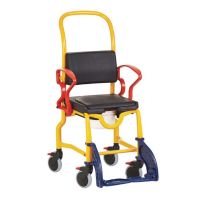 | Rebotec Augsburg Pediatric Shower Commode Chair View Product |
A pediatric shower commode chair is a two-in-one solution for tackling some of the most challenging yet essential ADLs: bathing and using the toilet. A commode chair is a portable toilet that does not need to be hooked up to plumbing to use. Most resemble a supportive chair with a conventional toilet seat that leads to a removable container below that can be easily cleaned. Some types of commode chairs are designed to fit over your toilet.
Children who need more extensive assistance with bathroom mobility can benefit greatly from the versatility of a shower commode chair. It reduces the need to transfer from one chair to another for bathroom purposes. Many shower commode chairs are compatible with accessories and options such as privacy covers, lap bars, slanted seats, rubber tips in place of wheels, and footrests.
Best Shower Commode Chair: Rebotec Augsburg Pediatric Shower Commode Chair
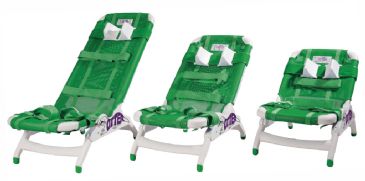 | Drive Medical Otter Bathing System Folding Bath Chair View Product |
As its name implies, a bath chair is a seat designed to fit into your bathtub so that your child can be partially submerged. Typically positioned lower in the tub than a standard shower chair, many bath chairs allow children to enjoy bathtub play safely. Of course, it is also possible to adjust a bath chair to be above the water so that the child is at a more comfortable height for the caregiver.
There are plentiful options available within this category, from models offering basic position support to more complex models with features such as adjustable recline and seat depth, antimicrobial seat coverings, and adjustable safety straps. Bath chairs also come in multiple sizes to accommodate children from as young as 15-months into adolescence.
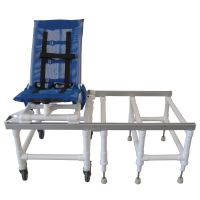 | Pediatric Articulating Shower Transfer System View Product |
A transfer bench is an important piece of equipment for families who are not easily able to modify their existing bathtub to be more accessible. Part of the transfer bench is positioned outside of the tub, and part of it sits inside. The sturdy frame has a seat that slides from one side of the bench to the other. The idea is that a child who is seated on the end of the bench outside of the tub can slide to the opposite end in order to bathe. This greatly eases transfer and reduces the risks associated with lifting a child over the edge of the tub.
As with many of these pieces of equipment, there are a variety of different features available for sliding transfer benches. Some may feature adjustable reclining backs for comfort and position support. Some variants have a detachable frame so that the more independent user can close the shower curtain or door for privacy.
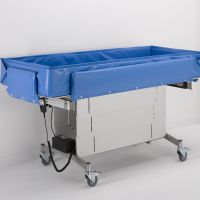 | Smirthwaite Mobi Height-Adjustable Shower Trolley View Product |
A pediatric shower trolley (also known as a shower gurney or shower bed) is a piece of equipment used to transport an immobile child for the purpose of bathing. It offers full-body support and enclosure for maximum safety and support.
There are two primary types: multi-positional trolleys and flat trolleys. Multi-positional trolleys feature an adjustable headrest to offer support to the head and neck. These beds are generally rated to support between 300 and 450lbs, depending on the model. Some may be foldable for easy storage, MRI safe, or even equipped with all-terrain wheels for supervised use outdoors or on the beach.
Flat shower trolleys are for people who must remain lying down while bathing or showering. These are frequently seen in clinical settings and use hydraulic or electric controls to raise or lower the working height of the bed. They might be wall-mounted or on casters for ease of transport.
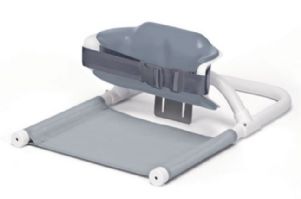 | Contour Wrap-Around Bath Support by Drive Medical View Product |
This is a type of bath chair that is designed to sit directly on the floor of the tub. This allows the child to be fully submersed, while also providing core stability and support. Due to the lower position, a bath back support is closest to a traditional bath experience
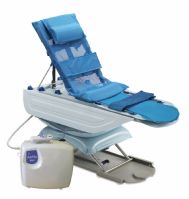 | Mangar Surfer Bather Pediatric Bathtub Lift View Product |
A pediatric bath lift is a piece of battery-operated equipment fitted with a seat designed to raise and lower a child into the bath, and lift them out when the bath is finished. Some are permanent home fixtures, while some models are designed to be portable. Some have adjustable reclining backs whereas some are in a fixed straight back position.
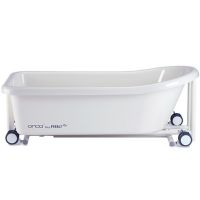 | R82 Pediatric Orca Height Adjustable Bathtub View Product |
Adapted tubs come in many different varieties but they are typically larger in terms of device size and financial investment than other bath assistance equipment. Use of an adaptable bathtub frequently means making renovations on an existing bathroom.
That being said, the convenience of a walk-in tub for transfer is optimal for many kids, parents, and caretakers. Other options include height-adjustable bathtubs, which are free-standing pieces of equipment featuring a full bath designed to support the child with the inclusion of power height controls.
Beyond the general use shower and bath chairs discussed above, there are some specific types of chairs that are especially well suited to certain needs and use. Depending on what you and your child want or need, there are some important considerations:
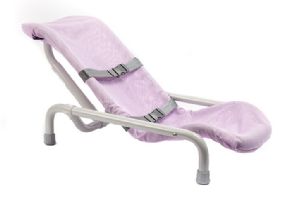 | Contour Deluxe Tilt-in-Space Pediatric Bath Chair by Drive Medical View Product |
There’s nothing better than a nice long bath-- and with the right shower chair, anyone can enjoy. For extended time spent in a shower chair, a tilt-in-space chair is ideal. This type of chair redistributes weight from off of the buttocks and onto the back, neck, and head. This leads to increased comfort due to reducing pressure on a specific point.
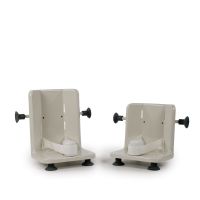 | Smirthwaite Pediatric Supportive Corner Bath Chair View Product |
In smaller bathrooms that are fitted with a standing shower stall only, you might be more limited on the type of shower chair that will fit. A corner bath chair is designed to sit with the backrest braced into the corner of a tub or shower. This design actually helps kids maintain an upright posture.
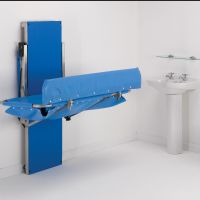 | Smirthwaite Hi-Riser Shower Stretcher View Product |
For maximum caregiver control and comfort, you need maximum maneuverability and an easy way to adjust the working height while bathing a child. The more robust options excel in this category -- caregivers will want some sort of hydraulic or power control of height and a large range of motion.
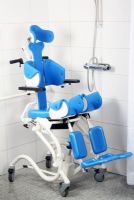 | Zitzi Starfish Pro All Ages Shower and Commode Chair View Product |
For kids who need really comprehensive reinforcement, a chair with multiple positioning supports is key. Individual and adjustable supports for arms, legs, and head ensure that the chair will accommodate any position necessary for optimal comfort and safety.
While many of the options detailed above might fit your and your child’s needs, some additional factors might be important to consider before making a purchase.
It is important to make sure that your new equipment is going to fit into your bathtub or shower. Take measurements of the area and be sure to refer to product dimensions before making a purchase.
Depending on the postural strength of the child, different levels of positional support may be necessary. This could be as simple as abductor padding designed for optimal hip positioning or something more comprehensive like a harness or hip belt.
Different safety measures are available on different types of shower chairs. A lap bar or safety belt might be necessary depending on the specific needs of the child.
Many shower chairs are portable and foldable, but that doesn’t mean you shouldn’t have a plan for storage before you make a purchase. Especially if multiple family members are using the shower, having a dedicated space to store the shower chair will prevent it from getting in the way of other bathroom activities.
There are many chairs on the market that are adjustable to accommodate for growth. That being said, thinking ahead when making a selection can be hugely beneficial. Some shower chairs are rated for higher weights and have a greater range of use.
The majority of types of bathing equipment discussed above come in fixed or adjustable versions. Talking to your child’s occupational therapist or care team can help determine the specific needs, but knowing if you will need to be able to adjust is important.
Shower chairs come in plenty of different sizes and heights. The height of the chair is not the only factor that will determine the working height for the caretaker, however. Consider the tub or shower that the chair will be placed in, and any specific height or angle needs for the child. Bad angles for caregivers can result in lower back strain.
It’s very important to make sure that your shower chair is going to remain stationary in your bathtub or shower. To this end, make sure to find a chair with high-quality non-slip feet or even suction cups.
Making sure that your bathroom is clean and free of bacteria is an essential part of caring for any child. So of course it holds for adaptive bathing equipment as well. Removable mesh backing or machine washable coverings are key here.
A chair that is prone to rust will need to be replaced, while rust-resistant materials will have much greater longevity. Make sure that the materials in the equipment are not prone to rust-- furniture grade PVC is a popular material for this reason.
A: While an in-depth answer will greatly depend on the individual needs of the child, there are some general tips to follow:
A: Absolutely! Bath time is a stimulating and enjoyable experience for all children. With the wealth of assistive devices available this experience can be enjoyed by children with functional impediments. Further, this can lead to greater independence and less intensive caretaker reliance.
A: Making use of one of the aforementioned adaptive bath devices will greatly assist in bathing a child with cognitive or motor disabilities. In some cases, however, a bed bath may be the only choice. Consult your child’s occupational therapist to help determine the proper assistive tool for your specific situation.
A: This is a bit complicated, but the short answer is ‘probably not.’ Medicare Part B does have provisions for durable medical goods, but shower chairs are typically not covered. However, a supplemental Medicare Advantage plan may have allowances for over-the-counter devices (such as shower chairs) at little additional cost.
A: A bath chair is a seat made to fit into your bathtub so that your child can be partially submerged safely. Typically positioned lower in the tub than a standard shower chair with different options for level of support.
A: A pediatric shower trolley (or gurney) is a flat or multi-positional bed designed to support kids who need to shower or bathe lying down. They usually have controls to adjust bed height.
A: A tilt in space seat adjusts backward while maintaining the angle of the lower joints. In this way, it redistributes pressure from body weight from off of the buttocks more evenly onto the posterior trunk and head.
Bathing is a positive experience and playtime for young babies, and it is important for overall hygiene for kids of all ages. While bathing a special-needs child may be intimidating at first glance, thanks to the wide array of adaptive equipment and safety measures, bath or shower time can be fun for everyone again!
Whether you are looking for simple posture support or a full bed with hydraulic lifts, there is a piece of bath equipment to fit the needs of every child. A shower chair might be an inexpensive and convenient solution for home use. Transfer benches can support autonomy for children or greatly ease the transfer process for caretakers. An adaptive bathtub may be a more expensive option, but it certainly provides a great user experience as it does not need to be fitted to an existing tub or shower.
Thanks so much for taking the time to read this article. Ultimately, many decisions will be between you and your child’s care team-- but being educated about all available home health aids and techniques is empowering and enlightening. To find more fantastic resources to help you care for the little one in your life, head over to Caregiver University.

Megan has been a part of Rehabmart since its inception nearly 20 years ago. For the past several years she has been enjoying her role as HR Director while maintaining her Physical Therapy license. When she isn't working on her next in-service or working to find a new team member, she enjoys her five children, helping those who have PT type ailments, baking, practicing yoga, and working out.